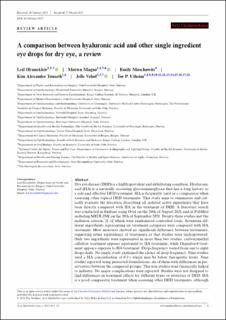| dc.contributor.author | Hynnekleiv, Leif | |
| dc.contributor.author | Magnø, Morten Schjerven | |
| dc.contributor.author | Moschowits, Emily | |
| dc.contributor.author | Tønseth, Kim Alexander | |
| dc.contributor.author | Vehof, Jelle | |
| dc.contributor.author | Utheim, Tor Paaske | |
| dc.date.accessioned | 2023-08-25T13:06:09Z | |
| dc.date.available | 2023-08-25T13:06:09Z | |
| dc.date.created | 2023-04-18T13:52:09Z | |
| dc.date.issued | 2023 | |
| dc.identifier.citation | Hynnekleiv, L., Magno, M., Moschowits, E., Tønseth, K. A., Vehof, J. & Utheim, T. P. (2023). A comparison between hyaluronic acid and other single ingredient eye drops for dry eye, a review. Acta Ophthalmologica. | en_US |
| dc.identifier.issn | 1755-375X | |
| dc.identifier.uri | https://hdl.handle.net/11250/3085838 | |
| dc.description.abstract | Dry eye disease (DED) is a highly prevalent and debilitating condition. Hyaluronic acid (HA) is a naturally occurring glycosaminoglycan that has a long history as a safe and effective DED treatment. HA is frequently used as a comparator when assessing other topical DED treatments. This study aims to summarise and critically evaluate the literature describing all isolated active ingredients that have been directly compared with HA in the treatment of DED. A literature search was conducted in Embase using Ovid on the 24th of August 2021 and in PubMed including MEDLINE on the 20th of September 2021. Twenty-three studies met the inclusion criteria, 21 of which were randomised controlled trials. Seventeen different ingredients representing six treatment categories were compared with HA treatment. Most measures showed no significant difference between treatments, suggesting either equivalency of treatments or that studies were underpowered. Only two ingredients were represented in more than two studies; carboxymethyl cellulose treatment appears equivalent to HA treatment, while Diquafosol treatment appears superior to HA treatment. Drop-frequency varied from one to eight drops daily. No single study explained the choice of drop frequency. Nine studies used a HA concentration of 0.1% which may be below therapeutic levels. Nine studies reported using preserved formulations, six of them with differences in preservatives between the compared groups. Thirteen studies were financially linked to industry. No major complications were reported. Studies were not designed to find differences in treatment effects for different types or severities of DED. HA is a good comparator treatment when assessing other DED treatments, although consensus after decades of use is still lacking for best choice of concentration, molecular weight and drop tonicity. Well-designed studies are needed to determine an evidence-based standard for HA treatment to be used as comparator. | en_US |
| dc.language.iso | eng | en_US |
| dc.rights | Navngivelse 4.0 Internasjonal | * |
| dc.rights.uri | http://creativecommons.org/licenses/by/4.0/deed.no | * |
| dc.title | A comparison between hyaluronic acid and other single ingredient eye drops for dry eye, a review | en_US |
| dc.type | Peer reviewed | en_US |
| dc.type | Journal article | en_US |
| dc.description.version | publishedVersion | en_US |
| dc.rights.holder | © 2023 The Authors. | en_US |
| dc.source.journal | Acta Ophthalmologica | en_US |
| dc.identifier.doi | https://doi.org/10.1111/aos.15675 | |
| dc.identifier.cristin | 2141627 | |
| cristin.ispublished | true | |
| cristin.fulltext | original | |
| cristin.qualitycode | 1 | |

